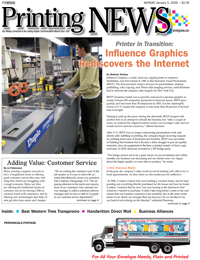|
  Jan. 5, 2009—We've all heard the pitches, and we've all seen the case studies from foreign markets. But now, the United States has a successful, big-name transpromo case study to call its own. Jan. 5, 2009—We've all heard the pitches, and we've all seen the case studies from foreign markets. But now, the United States has a successful, big-name transpromo case study to call its own.
Infoprint partnered with major hotel chain Best Western, which was looking to revamp its loyalty statements. They wanted to take it from the static, traditional piece to a strategic marketing vehicle that could, in turn, drive more and longer stays.
According to Lee Gallagher, manager, Direct Marketing Solutions, Infoprint, they decided to target specifically the fall promotion cycle, as well as the Best Western credit card. To begin, they looked at the demographics, and made sure they had a similar profile of customers in both the test and control groups. Best Western already has several different levels of loyalty groups, as well as branded groups like AAA, Nascar, and Harley Davidson, which are among the most active groups the hotel has. In designing this promotion, Infoprint targeted people not already in one of those affinity groups.
The control group was sent the basic pre-printed statement with inserts, like the company had been sending out already. The test group, however, received a highly personalized document targeted very specifically toward their demographics, stay history, etc.
"We hadn't looked at the statement as a vehicle for drumming up sales before, but it's been very successful," said Ryun Lambson, marking programs manager, Best Western. "People responded very well, were happy with layout, and were able to see what they needed, as well as the promotional items."
But Did it Work?
Because the test was run during what turned out to be difficult economic times, that makes the results Best Western and Infoprint got even more impressive. Here are a few statistics:
- 15 percent lift over the control segment in registrations within the first 30 days of the campaign;
- 39 percent lift over the control group for number of stays
- 34 percent lift over the control segment for number of nights stayed
- 30 percent lift over control for revenue generated; and
- 500 percent lift over the control group applying for the Best Western Rewards MasterCard.
In the end, Best Western reported that they saw an ROI of 278 percent on the transpromo statement, versus the 178 percent ROI the traditional test piece brought in.
ROI and customer retention weren't the only wins, either. Best Western was able to reduce the overall cost of the mailers by a significant amount. They went from sending up to three inserts with each piece to all onserts, reducing costs in both paper and postage. Not to mention, when they compared the pricing, it was less expensive to do full-color onserts than it was to produce black-and-white inserts, giving Best Western even more options.
In addition, because everything was printed in-line, instead of separately, the chain saved a significant amount of time and labor in assembling the mailers to go out the door. From the design stages to the actual mailing, the process took four weeks, proving it doesn't take large amounts of time and planning to produce an effective piece. Both Gallagher and Lambson credit a dedicated team willing to work together to get the job done as one of the major components of the project's success.
|


